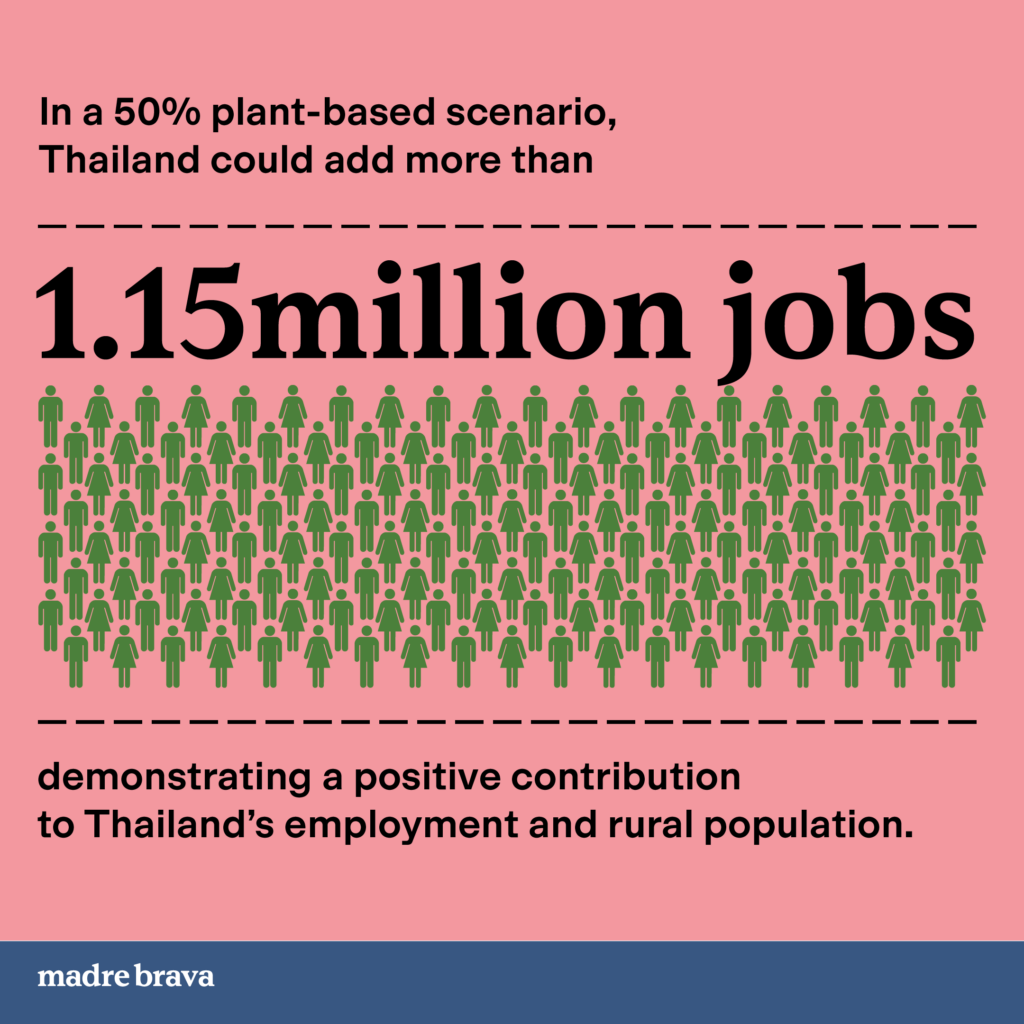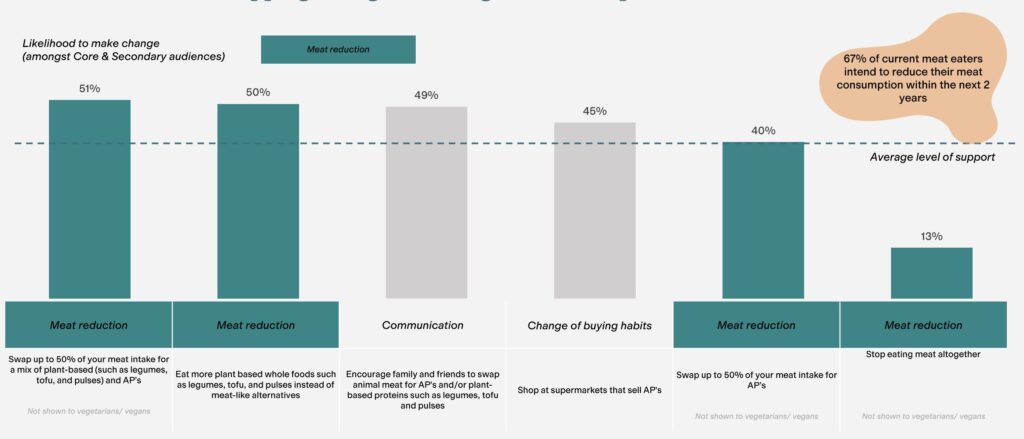Halving Meat Consumption Can Cut Thailand’s Emissions by 80% & Add $37B to the Economy
6 Mins Read
By replacing 50% of meat with plant-based proteins, Thailand could lower emissions by nearly 80%, while adding over a million jobs and boosting food security in the process.
Thailand could become a “kitchen of the future” with an emphasis on less meat and more plants, which would bring climate wins alongside a stronger national economy.
That’s if the country reduces meat intake by half and replaces it with plant-based proteins, according to a new report by Asia Research and Engagement for Madre Brava.
Between now and 2050, Thailand’s per capita meat and seafood consumption is on track to increase by nearly a third. That would mean increased production and expansion of intensive livestock and aquaculture both domestically and internationally, since the country’s animal food production relies heavily upon imported feed crops like maize and soy.
It would also end up using larger amounts of farmland and producing higher greenhouse gas emissions, going against Thailand’s climate goals – its second nationally determined contribution (NDC) to the Paris Agreement covers agriculture as a key focus sector, setting an unconditional emissions reduction target of 30% by 2030.
And in 2021, the government announced the Bio-Circular-Green economy as a component of the national economic strategy, with a focus on producing high-value, climate-friendly products that require fewer resources. The agrifood industry was one of four strategic sectors identified, and this is aligned with the government’s Future Food concept to transform Thailand into a global hub for sustainable, innovative food.
To showcase the potential of dietary change, the research looked at three scenarios – business as usual (BAU), a 30% switch from meat and seafood to plant proteins, and a 50% shift – and found that the latter presents outsized economic and environmental benefits to Thailand, and is the only way for the country to avoid breaching the climate-safety threshold (zero deforestation by 2025 and a 72% cut in emissions by 2050) set by international experts.
A 50% switch to plant proteins better for the planet and the economy

According to the report, a 180% rise in meat consumption since 1990 has nearly doubled the amount of land used for livestock production. In the BAU scenario, where people continue to eat more meat, the amount of land needed to meet this demand would rise to 6.15 million hectares in 2050 (a 42% increase from 2020).
But if plants make up 30% of Thailand’s protein supply by 2050, this increase would be limited to 13.5%. The 50% scenario is the only one where the demand for land is eased to 3.98 million hectares (a 7% decrease from current trends.
Similarly, if things stay as they are, the country’s greenhouse gas emissions will rise by 14.7% to reach nearly 45 million tonnes by 2050, a figure four times higher than the climate safety threshold. Even with several best-case mitigation scenarios – like a 30% reduction in enteric fermentation, manure emissions and feed emissions, alongside 20% lower food waste and a move towards a 100% clean energy target – emissions would still be above this threshold.
Plant proteins are required to achieve further reductions, since they are less emission-intensive than animal-based foods. The 50% scenario is the only one that stays within the climate safety threshold after 2050, resulting in a 79% drop in greenhouse gas emissions to reach 9.35 million tonnes of CO2e.
One of the major concerns around protein shifts is the impact on farmers and agricultural workers. The study found that while a 50% switch to plant-based proteins would lead to the loss of 900,000 animal husbandry jobs, the production of food-grade soybeans and plant proteins would instead create over two million new jobs. The net job creation would, therefore, be 1.15 million.
“The 50% scenario not only creates many more jobs, but also enables greater self-sufficiency for raw materials, and less reliance on animal feed imports,” the authors wrote.
They added that government subsidies and structural support enable the growth of the Thai livestock sector, with virtually no public sector investment in plant protein yet. In the 50% scenario, though, both government and private financing could help yield ฿1.3T ($36.6B) in economic value by reducing the reliance on imports. This would make Thailand more self-sufficient as well.
“Thailand is increasingly seeing the devastating consequences of climate change, consequences which will only intensify in the coming years,” said Madre Brava’s Thailand director, Wichayapat Piromsan. “Our country has a chance not only to make a strong bid to become the world’s kitchen for years to come, but to massively reduce the impact of our valuable protein sector on the climate.”

How stakeholders can enable the protein shift
The report chimes with previous analysis by Asia Research and Engagement, which stated that 30% of Thailand’s protein supply should come from alternative proteins if it is to decarbonise.
But this new study shows that only a 50% switch would truly keep Thailand on its path to net-zero. To get there, the Thai government needs to level the playing field between plant and animal proteins, which could involve carbon taxes on meat (à la Denmark) to incentivise sales of vegan food.
Policymakers should also ensure that government events feature plant-rich meals and consider offering more of these options in public canteens, including schools, hospitals and administrative buildings. The report further urged lawmakers to develop pathways with financial support and capacity-building programs for farmers to switch to plant-based crop production. Removing restrictions on labelling would help too.
Supermarkets and foodservice operators can play a role too. The former should set targets to increase the share of plant protein sales (mirroring trends in Europe) – lowering prices to eliminate the affordability barrier for plant-based foods, displaying them more prominently alongside meat, and providing information about preparation, nutritional content and health benefits would help retailers do so.
Caterers and foodservice companies, meanwhile, should increase the number of plant-based items, display these options alongside regular menus, and offer them at the same price as conventional meat.
Finally, food manufacturers should incorporate protein diversification strategies into their wider climate targets, and invest in R&D to make these proteins “tastier, less processed, more nutritious and more affordable”, with a view to cater for both exports as well as the domestic market.

Thai consumers are willing to make dietary changes, as Madre Brava’s research showed earlier this year. Two-thirds of respondents to its survey said they would reduce or stop eating meat in the next two years, with 44% wishing to replace it with traditional plant proteins, and 39% with novel alternatives.
“There are clear levers to pull here to ensure Thailand makes the most of this opportunity but it needs to happen now,” said Wichayapat. “Otherwise we risk getting left behind by the coming global shift in protein production.”



